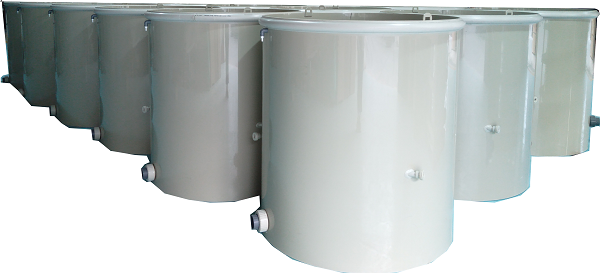Shrimps standard coarse, that is, we often say that temporary breeding, this method is to buy shrimp seedlings from hatcheries, in the standard coarse pool for rough 1 months or so, and then enter the shrimp pond to continue breeding. Shrimp seedling standard thick due to have great advantages: for example: the size of uniform shrimp, reduce mutual nibbling, reduce the time in raising prawn pond breeding, a year can breed more shrimp, efficient feed conversion rate and faster growth rate... Therefore, shrimp seedling standard thick, by more and more farmers accepted.
A, which kind of breeding mode, suitable for the standard thickness of shrimp seedlings
However, it is not yet clear which culture mode is most suitable for the thick stage of shrimp seedling. Therefore, this study conducted experiments and comparisons on three efficient breeding modes, which are respectively: Circulating aquaculture system (CW-RAS), outer pond culture (PT) and bioflocculating culture technology (BFT) were used to conduct experiments at three densities (500, 1000 and 1500 / m3), respectively. The experiment time was 35 days for the size of shrimp seedlings. Finally, the data of water quality, yield and survival rate were studied and analyzed.
In some previous experience, we believe that; The CW-RAS circulation system helps maintain water quality, but the up-front and operating costs of the system can be higher. PT system has high growth rate and low breeding cost. In addition, the growth rate and survival rate of shrimp larvae in the BFT bioflocs system are very good, which makes the BFT system more productive than the PT system.
2. Research conclusion and discussion
1, the water quality
In this study, temperature, salinity and pH values were kept within the acceptable range for shrimp to grow. At the same time, the total concentrations of TAN(total ammonia), nitrite and nitrate in all the experimental groups were within the range to ensure the safety of shrimp.
However, in this study, the average concentration of ammonia nitrogen in the CW-RAS circulating aquaculture system at D1500 was 1.23 mg/L, higher than that in the PT and BFT groups. In the PT group and BFT group, ammonia nitrogen was mainly removed by three methods: algal absorption, autotrophic bacteria utilization, and direct microbial transformation.
In the study of Ray et al.(2017), we found that the nitrite level in CW-RAS circulating water was low. This may be due to better treatment of water quality in the CW-RAS circulation system compared to other systems. Nitrate is the end product of the nitrification process, and the highest concentrations were observed in the CW-RAS and BFT bioflocs. In the PT system, microalgae helped to reduce nitrate concentrations, so nitrate levels in this group were lower than in other experiments.
The temperature, salinity and pH values of all experimental groups were suitable for the growth of Penaeus vannamei.
2. Performance of growth rate
The survival rate of Penaeus vannamei was much higher in the PT and BFT systems than in the CW-RAS system. In particular, the BFT bioflocs system produced higher biomass and yield, improved feed conversion and achieved more efficient feed utilization at a density of 1,500 tails per cubic metre. At the same time, in the BFT experiment, a lower coefficient of death was observed for shrimp at either density.
In the later part of this study, we observed a negative correlation between shrimp yield growth and culture density. The values of GFW, WG, GR and SGR are higher at a density of 500 tails /m³. The higher the density, the slower the shrimp will grow due to reduced water quality, natural productivity and living space.
Microalgae and bioflocs (bioflocs) should be paid the most attention by PT and BFT systems. Bioflocs are a natural food source for shrimp, higher than the CW-RAS recycling aquaculture system. In this study, the highest feed utilization efficiency observed in the BFT bioflocculation system was 500-1000 tails /m³. In addition, in this study, it was found that the implantation of microalgae in PT and BFT systems helped to improve the growth performance of Penaeus vannamei.
In the thick stage of the shrimp, the higher the density of the shrimp can change the size of the shrimp, and there will be inconsistency, which will be a problem for the future shrimp farming, because eventually when we sell the shrimp, the uniform size of the shrimp is a factor that affects the price. In our study, it was found that the size uniformity of CW-RAS was low, and the uniformity comparison of the three culture modes was as follows: CW-RAS < PT < BFT. This showed that over a period of 35 days, more than 97.5% of shrimp larvae had relatively uniform size in the BFT bioflocs system. Moreover, the growth rate is less affected by density.

In PT and BFT experiments, the survival rate of Penaeus vannamei was significantly higher than that of CW-RAS
3. The cost of breeding
In the selection of CW-RAS, PT and BFT bioflocs as our shrimp seedling cultivation mode, not only the efficiency of shrimp breeding was taken as the determining factor, but also the management strategy was analyzed through economic efficiency, and the investment was optimized to obtain the best return.
In this study, the CW-RAS recirculating aquaculture system has the highest cost, the PT system has the lowest cost, and the BFT has the highest breeding effect. Therefore, this study finally concluded that the PT system has the best cost advantage under the condition of 500 tail /m³.
III. Summary:
In fact, both CW-RAS, PT and BFT systems are suitable for the standard size of shrimp seedlings, but it is just whether these breeding systems are suitable for themselves or not. In general, the BFT system achieves the best breeding efficiency under the condition of 500-1000 tails /m³. The PT system (implanted microalgae) achieves the lowest cost at a density of 500 tails /m³.

Contact: Jack Lee
Phone: 13560241557
Tel: 020-22921925
Email: 1291544875@qq.com
Add: Guangdong guangzhou